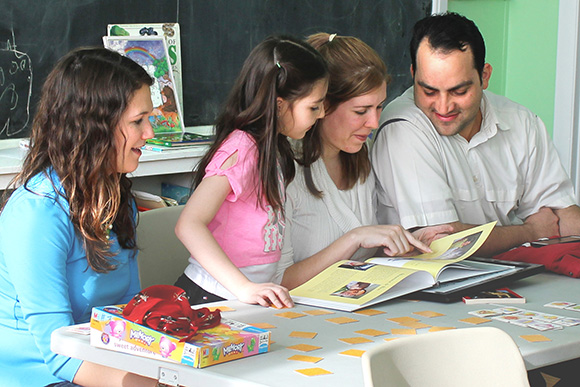
Notre Dame student Colleen Wade watches as the Valero family reads a book chronicling multiple generations of their family history. Wade made the book as part of a community-based learning Spanish course in the Department of Romance Languages and Literatures.
Spanish Students Connect with South Bend Through Community-Based Learning
It starts with an idea. It ends with impact.
Through a series of new community-based learning Spanish courses at Notre Dame, undergraduates are improving their language skills both inside and outside the classroom.
Interacting with native Spanish speakers in community centers and schools offers educational opportunities that enhance what students acquire via textbooks and lectures, said Rachel Rivers Parroquín, director of the Spanish community-based learning program supported by the Department of Romance Languages and Literatures and the Center for Social Concerns (CSC).
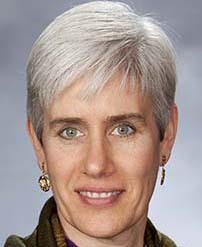 Rachel Rivers Parroquín
Rachel Rivers Parroquín
“Students realize that these aren’t just numbers, these aren’t just stories—these are people’s lives,” Parroquín said. “It really brings home to them that what they’re learning has value and captures the essence of what Latino people are living.”
Spanish students in intermediate-level and community-based learning classes now average about 3,000 hours of service per year in South Bend. The model is based on the idea that a faculty member and local organization leader are co-educators—the experience is designed to be mutually beneficial to both the Notre Dame class and the community group.
To extend and deepen these campus-community partnerships, the CSC hosts an annual Community Engagement Faculty Institute. Participants visit partner organizations, explore ways to incorporate community-based teaching and research into their curriculum, and learn about the theory and practice of community engagement.
“We’re not charging in on a white horse to save people or solve all their problems,” Parroquín said. “The students are going in to learn from the community partner, and usually they realize well before the end of the semester that they are gaining as much as or more than what they’re giving.”
Over the past three years, three associate professional specialists in the Department of Romance Languages and Literatures have attended the institute and gone on to pursue CSC course-development grants for Spanish classes with community-based learning components.
Writing a Family’s History
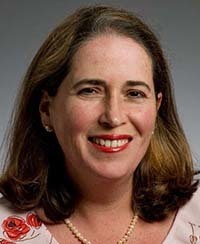 Tatiana Botero-Jáuregui
Tatiana Botero-Jáuregui
Tatiana Botero-Jáuregui had an idea.
She wanted her students to learn about Latin American history and the causes and effects of immigration. She also knew that, while tight-knit family relationships are an important component of everyday life in Hispanic communities, many immigrants don’t have the time or ability to make a record of their personal family history.
What if her students could do that with them, simultaneously improving their Spanish while conducting interviews and writing a family’s story for new generations to learn about?
After attending the CSC’s Community Engagement Faculty Institute twice and receiving a course-development grant from the CSC, Botero-Jáuregui began teaching Immigration and the Construction of Memory, a fifth-semester language course offered in spring 2014 and 2015.
In addition to classroom work, students went to El Campito, a bilingual preschool on South Bend’s west side, working in groups of three or four to interview multiple generations of a family, gather photos, and write and design a hardcover book.
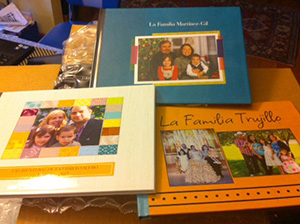 Family history books created through Tatiana Botero-Jáuregui’s course.
Family history books created through Tatiana Botero-Jáuregui’s course.
“If we don’t have the community-based learning component, then it’s basically just a simple history class,” she said. “With this, they get to actually see the other side, to see the face of immigration. The issue is much more human.”
As a result, students learned why people immigrate to the United States, what pushes them to come here, and what’s happening in their native countries.
She hopes that the experience touches their hearts, shapes their worldview, and perhaps guides their future plans.
“They learn that through really hard work and love and commitment, these people are able to have the American dream,” she said.
Inspiring Future Learners
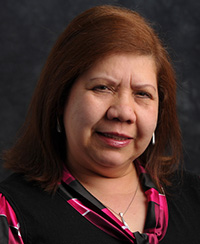 Maria Coloma
Maria Coloma
María Coloma had an idea.
The University’s mission is, in part, to instill in students a sense of human solidarity and concern for the common good. South Bend high schools, meanwhile, have a large Latino population that faces unique challenges in furthering their education.
What if Notre Dame students could improve their Spanish skills by tutoring high school students? And, in turn, what if those high school students were then exposed to the world of higher education?
After attending the Community Engagement Faculty Institute and receiving a course-development grant, Coloma created Language, Culture, and Community, a new course with an emphasis on community engagement, outreach, and education.
Coloma’s class worked with students at Washington High School, which is about 15 percent Latino. They helped the teenagers with English classwork—something that’s difficult for second-generation immigrants to get at home—and talked to them about the college financial-aid application process. The high school students also attended Notre Dame sporting events, toured campus, visited residence halls, and attended a dinner at the CSC.
“The community benefits because they know that Notre Dame cares,” Coloma said.
Her students, meanwhile, were exposed to situations and experiences they may not have encountered in their own lives. They learned about Latino culture, customs, and traditions, and saw how the community fits into the city of South Bend.
“By pushing new experiences, students are able to explore both what they enjoy doing and what they believe to be their place in society,” said Coloma, who is teaching the class again this semester. “As these students graduate and spread out into their own communities, the hope is they will use some of the skills learned here in their own future lives.”
Creating Stories with Children
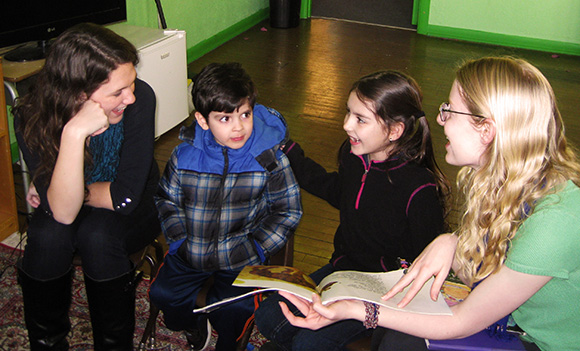 Spanish students Colleen Wade (far left) and Rose Urankar (far right) share a book with students.
Spanish students Colleen Wade (far left) and Rose Urankar (far right) share a book with students.
Andrea Topash-Ríos had an idea.
Students sometimes avoid upper-level language courses, intimidated by the shift toward literature they’re required to read and discuss. What if there was a way to help them make that transition, helping them refine their grammar while also acquiring new vocabulary?
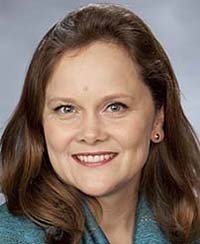 Andrea Topash-Ríos
Andrea Topash-Ríos
Could college students (native English speakers learning Spanish) simultaneously learn and teach by reading storybooks to children (native Spanish speakers learning English)?
She attended the Community Engagement Faculty Institute twice, then used a course-development grant to build Bridging the Gap: Multiple Literacies and Connecting Society, Community, and Self, a fifth-semester Spanish course she will begin offering next spring.
Students will volunteer at least 10 hours per semester with pre-K children at El Campito, an early childhood center in South Bend. They will read books to the children, then help them write their own creative story—which will be added to the center’s reading library.
Topash-Ríos believes her students will improve their Spanish skills, the younger students will improve their English skills, and a new connection will form between social spheres.
“They can experience some of the things that are really vibrant about South Bend that they don’t know about—how this is a living, breathing, interesting community,” she said.
Students will broaden their horizons, she said, as they interact with people facing issues that can seem merely theoretical when discussed in the classroom. And such an experience underscores the relevance of higher education.
“The students who do community-based learning as a whole are more workforce-ready than students who have stayed on campus,” she said. “They’re more willing to acknowledge the kinds of issues that communities are facing. They’ve gotten out and experienced real people dealing with real issues. It really broadens their horizons.”
Making a Difference
 Notre Dame students Katie Eilert and Caroline Spencer talk with Adrian Martinez at a South Bend preschool.
Notre Dame students Katie Eilert and Caroline Spencer talk with Adrian Martinez at a South Bend preschool.
Thomas Anderson has seen the impact.
As chair of the Department of Romance Languages and Literatures and a professor of Spanish, he’s witnessed the success of courses that get students into the community.
The classes focused on language—as well as upper-level literature courses with community-based learning components offered by Marisel Moreno, an associate professor of Spanish—have inspired South Bend residents, encouraged faculty to grow in their teaching, and accelerated and enhanced learning.
“Students have come to realize the great benefits of this particular pedagogical model,” Anderson said. “Most importantly, they have come to realize that within the context of equitable partnerships, everyone—from community organizations, to students, to faculty members—benefits from the experience.”
Originally published by at al.nd.edu on September 22, 2015.